For several months, we have been updating our readers on the coronavirus and how it has affected Costa Rica. That post has mostly formal details on the current number of cases and measures that the government is taking. But we thought it also would be interesting for you to hear about our personal experience and what is happening locally as the pandemic progresses. In this post, we’ll share these details about life in Costa Rica during Covid-19.

The Beginning – Covid-19 in Costa Rica
Costa Rica saw its first cases of Covid-19 at the beginning of March 2020. As a country, we had already watched the virus spread in China, Italy, and other parts of Europe. Immediately, once the first case arrived, the government reacted. By March 18, Costa Rica’s borders were closed. At the time, we had around 50 cases and one death from the disease.
For us, those first few weeks of March were really intense. This was mostly because our travel agency had many clients already in Costa Rica or due to arrive soon in March or April. Stress levels were high. Everyone was emailing us for updates on the situation in Costa Rica.
They wanted to know if the government was going to close borders, what would happen to them if they closed while they were here, and how refunds would work. We even had a client trapped in Italy, who was supposed to travel here but got locked down because of the escalating situation.
Like most companies, we encouraged being cautious and careful, even if that meant postponements or cancellations. By March 21, we had helped get our last clients out of Costa Rica, cutting their trip short by a few days. They got to the airport and on one of the very last regular flights out of the country.
Shutting Down
By late March, it was like someone had flipped a switch. Costa Rica had been in the middle of a booming “high season” as they call it here, then suddenly there were zero tourists and no money coming in.
The local economy relies heavily on international tourism. It is one of Costa Rica’s main industries. Hotels, restaurants, tour companies, transportation companies, and attractions that had just been at their peak were suddenly now closed. These businesses make most of their money from December to the end of April, so it was a big hit to be closing in March. Thousands of workers were laid off. And because many locals don’t have much savings, it has been very hard on people.
Additionally, in March, the Ministry of Health began restricting businesses and services. Schools were closed first, along with large events, amusement parks, bars, and nightclubs.
Many restaurants near us on the central Pacific coast either closed due to lack of business or only offered take-out. Access to beaches and national parks also was prohibited.

By month’s end, almost everything was closed except grocery stores, hardware stores, pharmacies, and medical clinics. While there was no formal stay-at-home order, driving restrictions had us only able to leave on certain days between certain hours.
Staying Informed
At the end of March, there were around 300 cases of Covid-19 in the country, with 15-30 new cases per day. The coronavirus was all over the news. The Ministry of Health started running ads everywhere (e.g., TV, social media, radio), telling people to wash their hands and keep a safe distance.
The Ministry of Health was doing (and continues to do) a live press conference every day, where they share the latest numbers and any new regulations taking effect. Health Minister Daniel Salas also does a small lecture or pep-talk about the importance of the health measures to get the point across to the general public. Salas is a doctor with two master’s degrees (public health management and epidemiology) and incredibly well spoken and reasoned, in our opinion.
At this point in the pandemic, much of the country seemed to be taking things seriously. Costa Rica’s public health care system normally has less than 300 intensive care units for the whole country. But only around 50 of those are typically open from what we’ve heard from news reports. Seeing health care systems be quickly overwhelmed in other countries and being informed from our own health officials of it possibly happening here made people think.
Adapting to Stay at Home
Costa Rica’s reaction to quarantine was impressive. Overall, people were staying home and that really helped keep the coronavirus numbers in check. After a couple of weeks (by mid-April), new cases were down to single digits per day. And with recoveries, the curve of active cases began to slowly trend downward.
Also, with the lockdown, new services were popping up fast. We’ve always thought that Ticos were resourceful, but after this pandemic, we think it now more than ever. Below we’ll talk about some of the adaptations that people have made to cope with the changes.
Note: We realize that many of our readers, friends, and even family have different opinions on what was/is best during this crazy time. For us, it was/is to be overly cautious and maintain social distance. Therefore, our experiences shared here might be somewhat different than others also living in Costa Rica.
Schools
When schools were closed in mid-March, it was quickly announced that learning would continue online. That meant different things for different schools, of course. Some public schools didn’t have as many resources as others, and from what we have heard, up to half the country’s public-school students weren’t getting much of anything.
Our oldest son goes to a private school and that experience has been better (although challenging as many of you readers with kids can relate to). For us, it meant a short online video session with the teacher each day and some other things to practice at home. He’s only in kindergarten so it wasn’t/isn’t too intense but enough to keep him on track.
Filling the rest of the day with kid activities was and continues to be the bigger struggle! We even tried to help other families around the globe by coming up with some Virtual Field Trip posts of our own.
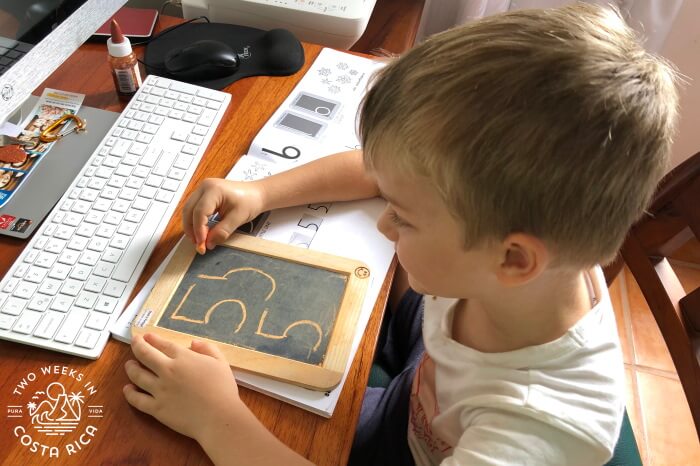
Getting Local
Something really cool that started happening where we live is that we could get most things a lot more locally. We have always supported the community farmer’s market. We also regularly purchase some groceries from the mini-super (small store) in town. But many of our household items usually came from bigger stores and chains nearby. Now that we were stuck at home and a bit intimidated to go to the larger grocery stores, we had to look for other options.
Luckily for us, new offerings were all around. Our small grocery store started taking orders through WhatsApp and delivering to our door. If they didn’t have something, they would help find an alternative or order it for us. People in town compared prices against the big chains and they were similar or sometimes even less.
Organic produce, which we normally had to get at the weekly farmers market, could now be purchased online through a small delivery company. Not only that, but they began partnering with many local suppliers to get other items like baked goods, jams, dairy products, chocolate products, and even bath items.
And one of the best additions for us is our new source for yogurt. A family we know who has a dairy farm started delivering the most amazing yogurt as well as cheese and fresh milk. They had previously sold mostly to restaurants but adapted when many of those closed.
Pair that with the egg delivery that we were already using from another farm, and most of our weekly grocery needs were taken care of.
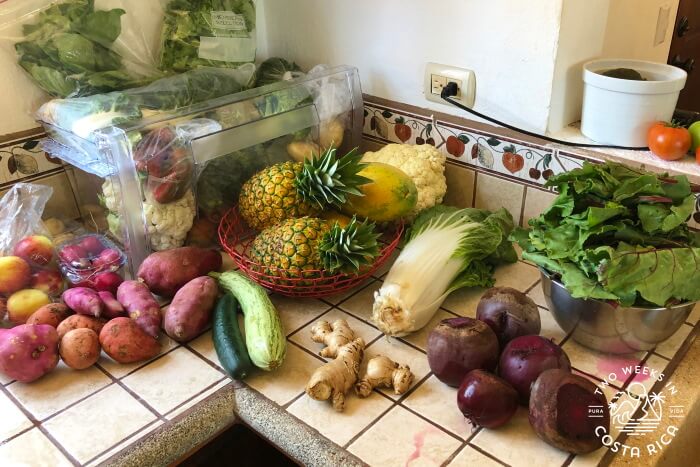
We were also able to purchase some foods from locals in our community who were out of work. Our cleaning person, for example, has been periodically selling things like arroz con pollo, tamales, and other treats. Some local chefs who aren’t back to work yet also have been selling their dishes on and off to help support their families.
For missing items, we have managed to stock up a couple of times at PriceSmart near San Jose. This is a big box store, which is owned by Costco. They started a curbside-pickup service, which has been very easy to use.
Gradual Reopening with New Health Measures
By mid-May, Costa Rica was getting world praise for controlling Covid-19 and keeping the death rate very low (just 10 deaths from around 840 cases). New cases were often in the single digits per day. With two weeks of decreasing cases, the government announced plans for a very gradual reopening. You can check out our other coronavirus post for the phased plan. For us, this meant that some important things would be opening back up.
Back at the Beach
Beaches were the highlight for us since we live at the beach and all really needed to get out of the house. Even though they were only open only from 5:00-8:00 a.m., we made the best of it. Luckily, we only live about five minutes away so early mornings were still doable.
The local surfers may have been the happiest of all. They had been pretty vocal about being kept off the beaches during lockdown. A few were even chased off by police, which made news headlines.
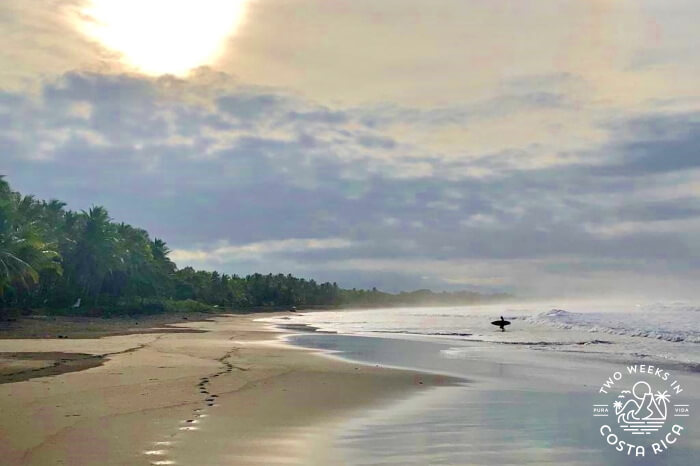
National Parks
Another highlight of reopening was that some national parks were opening at 50% capacity. We were able to visit both Carara National Park and Manuel Antonio National Park.
On both visits, there were only about 30 people in the entire park. That’s fairly normal for Carara, but Manuel Antonio usually has hundreds of visitors daily during peak season. The number of trails was limited, but it was still really nice to get out and hike.
We were impressed with the parks’ safety measures too. Per Ministry of Health guidelines, both required handwashing before entering and the staff was either wearing masks or face shields, or they were behind glass. They also took the temperature of the person buying the tickets, although not the whole family.
The facilities were modified a bit. At Carara, the benches along the main trail had been sectioned off with caution tape to distance people. Both parks had lots of soap and sometimes alcohol gel in the bathrooms, a big improvement from the norm. Manuel Antonio had restricted the use of many of their picnic tables and kept the beach sections closed to prevent people from gathering.
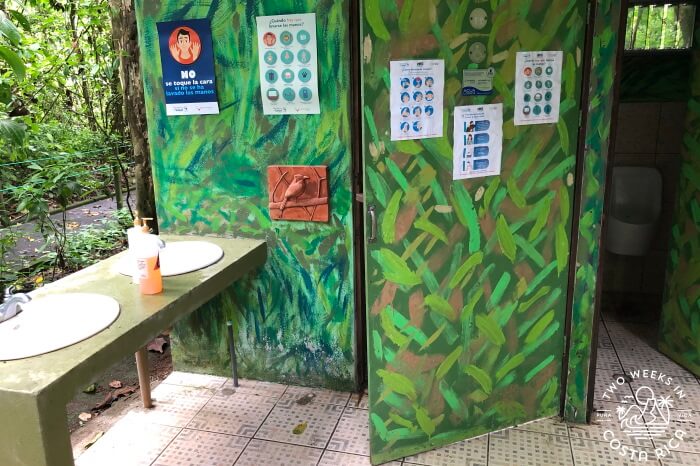
Stores and Restaurants
During reopening and with the low number of cases, we also felt more comfortable getting out to the store or grabbing something from a restaurant (allowed to be open at 50% capacity). For these businesses, things had changed too. They had to comply with a lot of new regulations.
Grocery stores had all their staff wearing masks. Bigger ones also set up Plexiglas petitions around registers. Employees were either spraying alcohol on the carts or asking you to do it when you enter. Floors were marked so you would stand at a distance from other customers when waiting in line. Many supermarkets had senior hours’ as well.
At the Ekono department store that we visited in Jaco, they were allowing only around 10 people inside at once. The line outside was spaced apart and you had to have your temperature taken before entering as well as sanitize your hands at a special station.
On a visit to the ice-cream shop, the staff was wearing face masks. Servers at restaurants were not required to wear any face coverings, though (until recently), so that was a turnoff for us. But we did still get takeout. For people dining in, the tables had been spread apart to keep a distance.
Lightening Up
During May and into June, we noticed that many people weren’t being as cautious as before. They definitely seemed to be lightening up. Some people we know were getting together for small gatherings or making trips to San Jose or other higher risk places to get errands done. Locals were trying to get back to work so that they could put food on the table. We completely understand how hard it is for people right now, but much of the lack of social distancing didn’t seem to have much to do with work.
On a drive through bigger beach towns like Jaco or Quepos, you may have seen a few people wearing a mask, but mostly it was only employees at stores or delivery drivers. Really only those who were required to wear them. One rainy afternoon in Jaco, we saw dozens of people crowded under a bus stop, none of them wearing a mask or social distancing.
On a drive Matt took to PriceSmart in Alajuela (near San Jose), he did see more of the public wearing masks, but not the majority. With more active cases in that area, it made sense to see more masks.
But overall, people seemed to have had enough of it. We were starting to get stir crazy too.
The Second Phase, the Second Wave
The second phase of the government’s reopening plan went on as scheduled on June 1. Now, larger hotels and function halls could be partially opened. Restaurants could open on the weekends too (take-out only), instead of just during the week. The idea was to encourage local tourism and get some of the economy going again. We were all encouraged to stay within small “social bubbles.”
As has happened elsewhere in the world, concurrent with reopening, cases began to steadily rise. New cases were numbering in the 20s or 30s per day, with some peaks into the 50s.
Suddenly by mid-to-late June, there were record-breaking days of new cases in the 60s, 70s, 80s, and even 147.
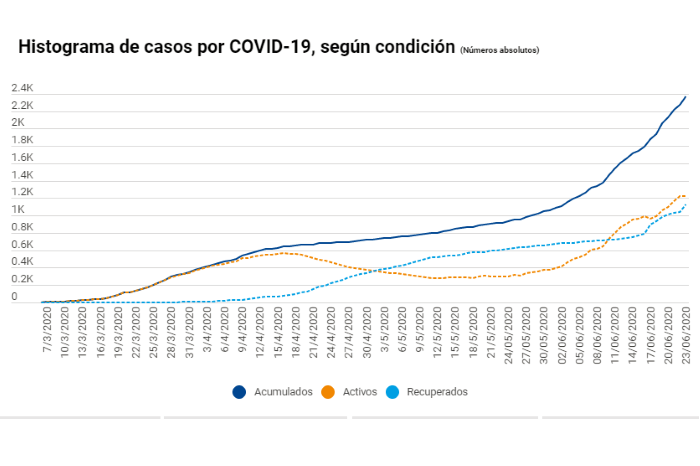
Nicaragua
A big issue starting in May was Costa Rica’s northern border with Nicaragua. From what we have read, the situation in Nicaragua sounds a bit out of control and the virus is spreading quickly without any government intervention.
There are many Nicaraguans that live in Costa Rica, and therefore, a portion normally travel back and forth to visit family or for work. With the borders closed, some have been entering the country illegally, either to get back to loved ones or to find a safer place than their home country.
Costa Rica has been trying to patrol the northern border and has set up checkpoints and a small airport for surveillance. But a lot of the territory is wetlands and hard to traverse. Many Nicaraguans still have managed to find their way through.
Some Nicaraguans have tested positive after riding a bus in Costa Rica or working alongside others in the agricultural sector. Cases have spiked in certain northern areas of the country, resulting in region-specific restrictions and illegal worker crackdowns.
Truck Drivers
Truck drivers from both Nicaragua and Panama to the south also have been an issue. A lot of trucks pass through both borders, and for a while, the Ministry of Health was requiring Covid-19 tests. These took around 24 hours, so it created a big traffic backup at both borders and some tensions between governments.
Since then, Costa Rica has been allowing police-escorted convoys of trucks to pass from one border to the next, without testing, with a controlled stop along the way. We have seen several of these on the highway near our house. They include about 20 tractor-trailer trucks and usually three police escorts.
Party Time
Amidst the spiking cases, we also have been seeing some bigger gatherings make the news. One family get together of 50 people resulted in at least 30 new cases. Another was said to be a baby shower, where several attendees then tested positive, including the expectant mother.
Over Father’s Day weekend, the Health Minister urged everyone to celebrate from afar and even issued harsher driving restrictions. But news headlines still told some stories of large gatherings getting broken up by police.
Where Is It Headed?
Costa Rica’s first wave of coronavirus was small and controlled. At the peak, there were around 600 or so total cases and it felt like we were winning when daily cases dropped into single digits and people started to recover.
Now, almost suddenly, we are in the second wave, with around 2,500 accumulated cases and the curve is still rising. New cases are in double, and sometimes triple, digits each day, even with the same amount of testing (only around 400-500 tests per day). For us, the end is nowhere in sight, but we still have hope.
New Measures
Just this week, Costa Rica announced that masks will be required in some situations starting on June 27. This includes anyone who interacts with the public (e.g., employees at restaurants, banks, churches, cinemas, theaters). The general public is required to wear them at banks, cinemas, theaters, and on public buses and in taxis.
The third phase of reopening (originally scheduled for June 20) was initially delayed after the recent spike in cases, but resumed on June 27 with modifications. See our original coronavirus post for more information.
We’re still waiting for details, but with these new measures, it seems that the government won’t let up on their fight to control the pandemic.
Uncertainty but Optimism
International Tourism
A big uncertainty for many, including us, is the reopening of international borders. The government has been very vague about when borders will reopen. This week (June 22), they announced that it would be a very gradual reopening, and countries with high transmission (like the US perhaps) would not be allowed to enter for some time. At the time of this writing, they have still not specified a date that airports will open again or what countries will be permitted entry.
In the back of our minds, we know that they can’t just allow people to travel in from other countries, but waiting for a set plan has been hard on all of us in the tourism sector. Many hotels, restaurants, and tour companies have been preparing to reopen, only to be shut down because of a new restriction or extended border closure.
People here are really struggling financially, and many are very frustrated with having to keep waiting. In some tourism towns, grassroots organizations have formed to push the reopening. Still other locals are nervous and not ready to get back to normal life. Schools are supposed to reenter session after July vacations for some grades, but there are many concerned parents.
Looking to the Future
It is a very difficult time for everyone, but our hope is that people heed the directives of the Ministry of Health now so that we endure this for the least amount of time possible. Typically, enforcement in Costa Rica isn’t great so we will have to see how the new mask requirements go.
Costa Rica has banded together and shown ingenuity before, and we think they will again. Already there is a lot of patriotism behind new efforts. We have seen face shields being 3D printed by concerned citizens, a university has developed an easy-to-make respirator, and the country’s snake-venom scientists are testing a scalable blood plasma treatment, which could even provide a sort of vaccine.
Time will tell for both Costa Rica and the rest of the world, but one thing is for sure, we can’t wait to get you all back here for a visit soon!
What is it like where you live right now with Covid-19? Let us know in the comments below.
Looking for more information? Check out these posts.
Costa Rica and the Coronavirus: Stay up-to-date on the situation in Costa Rica with this detailed post.
Life in Costa Rica: Interested in moving to Costa Rica? Our Life in CR section has many articles about getting residency, moving with kids, starting a business, house sitting, and more.
Recipes: If you can’t get to Costa Rica, one of the best ways to bring yourself here is through food. Check out our recipes for arroz con pollo and homemade beans.

